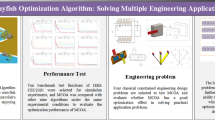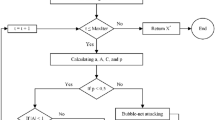Abstract
Remediation of contaminated sites requires an optimal decision making system to develop remediation techniques in a cost-effective and efficient manner. A coupled simulation–optimization solution approach, based on the finite element method (FEM) and a modified firefly algorithm (MFA), is developed in this study for optimal contaminated groundwater remediation design. A new modified firefly optimization algorithm is proposed by modifying the traditional firefly algorithm in three ways: (i) adding memory, (ii) preventing premature convergence to local optima and thus accelerating the optimization process, and (iii) proposing a new updating formula. Modifications performed in the present study improved the applicability and efficiency of the traditional metaheuristic firefly optimization algorithm, and led the MFA to outperform both its predecessor and conventional optimization methods (e.g., genetic algorithm). A hypothetical, unconfined contaminated field is considered and remediated by considering pump and treat and flushing methods. Pumping rates are considered as design variables while the number of pumps and pump locations, as well as the pumping period, are initially assumed. The coupled simulation-optimization model (FEM-MFA) proposed in this study constitutes an effective way to determine an optimal remediation design for a contaminated aquifer. The results of the present investigation will contribute to improve groundwater management in contaminated aquifers.











Similar content being viewed by others
References
Adamowski J, Chan H, Prasher S, Sharda VN (2012) Comparison of multivariate adaptive regression splines with coupled wavelet transform artificial neural networks for runoff forecasting in Himalayan micro-watersheds with limited data. Journal of Hydroinformatics, 3, 731–744
Ayvaz MT (2010) A linked simulation–optimization model for solving the unknown groundwater pollution source identification problems. J Contam Hydrol 117(1–4):46–59. doi:10.1016/j.jconhyd.2010.06.004
Bashi-Azghadi SN, Kerachian R (2010) Locating monitoring wells in groundwater systems using embedded optimization and simulation models. Sci Total Environ 408(10):2189–2198. doi:10.1016/j.scitotenv.2010.02.004
Bashi-Azghadi SN, Kerachian R, Bazargan-Lari MR, Solouki K (2010) Characterizing an unknown pollution source in groundwater resources systems using PSVM and PNN. Expert Syst Appl 37(10):7154–7161
Batu V (2006) Applied flow and solute transport modeling in aquifers: fundamental principles and analytical and numerical methods. Taylor & Francis Group
Chadalavada S, Datta B, Naidu R (2011) Optimisation approach for pollution source identification in groundwater: an overview. Int J Environ Waste Manag 8(1):40–61. doi:10.1504/ijewm.2011.040964
Chang L-C, Shoemaker CA, Liu PLF (1992) Optimal time-varying pumping rates for groundwater remediation: application of a constrained optimal control algorithm. Water Resour Res 28(12):3157–3173. doi:10.1029/92wr01685
Chu HJ, Chang LC (2009) Application of optimal control and fuzzy theory for dynamic groundwater remediation design. Water Resour Manag 23(4):647–660
Gandomi AH, Yang X-S, Alavi AH (2011) Mixed variable structural optimization using firefly algorithm. Comput Struct 89(23–24):2325–2336. doi:10.1016/j.compstruc.2011.08.002
Guan J, Aral MM (1999) Optimal remediation with well locations and pumping rates selected as continuous decision variables. J Hydrol 221(1–2):20–42. doi:10.1016/s0022-1694(99)00079-7
Guan J, Aral MM (2004) Optimal design of groundwater remediation systems using fuzzy set theory. Water Resour Res 40(1):W015181–W0151820
Halbe J, Pahl-Wostl C, Sendzimir J, Adamowski J (2013) Towards adaptive and integrated management paradigms to meet the challenges of water governance. Water Science and Technology: Water Supply, 67, 2651–2660
Huang C, Mayer AS (1997) Pump-and-treat optimization using well locations and pumping rates as decision variables. Water Resour Res 33(5):1001–1012. doi:10.1029/97wr00366
Kazemzadeh-Parsi MJ (2015) Optimal shape design for heat conduction using smoothed fixed grid finite element method and modified firefly algorithm. Trans Mech Eng Iran J Sci Technol Accepted
Kazemzadeh-Parsi MJ (2014) A modified firefly algorithm for engineering design optimization problems, Iranian Journal of Science and Technology 38(M2):403–421
Kazemzadeh-Parsi MJ, Daneshmand F (2010) Cavity-shape identification with convective boundary conditions using non-boundary-fitted meshes. Numer Heat Transf B Fundam 57(4):283–305
Li X, Tomasgard A, Barton P (2011) Nonconvex generalized benders decomposition for stochastic separable mixed-integer nonlinear programs. J Optim Theory Appl 151(3):425–454. doi:10.1007/s10957-011-9888-1
Meenal M, Eldho TI (2012) Simulation-optimization model for groundwater contamination remediation using meshfree point collocation method and particle swarm optimization. Sadhana Acad Proc Eng Sci 1–19
Mirghani BY, Mahinthakumar KG, Tryby ME, Ranjithan RS, Zechman EM (2009) A parallel evolutionary strategy based simulation–optimization approach for solving groundwater source identification problems. Adv Water Resour 32(9):1373–1385. doi:10.1016/j.advwatres.2009.06.001
Mondal A, Eldho TI, Gurunadha Rao VVS (2010) Multiobjective groundwater remediation system design using coupled finite-element model and nondominated sorting genetic algorithm II. J Hydrol Eng 15(5):350–359. doi:10.1061/(asce)he.1943-5584.0000198
Sepehri A, Daneshmand F, Jafarpour K (2012) A modified particle swarm approach for multi-objective optimization of laminated composite structures. Struct Eng Mech 42(3):335–352
Sharief SMV, Eldho TI, Rastogi AK, Gurunadha Rao VVS (2012) Optimal groundwater remediation by pump and treat using FEM- and EGA-based simulation-optimization model. J Hazard Toxic Radioact Waste 16(2):106–117
Singh TS, Chakrabarty D (2011) Multiobjective optimization of pump-and-treat-based optimal multilayer aquifer remediation design with flexible remediation time. J Hydrol Eng 16(5):413–420
Sreekanth J, Datta B (2011) Coupled simulation-optimization model for coastal aquifer management using genetic programming-based ensemble surrogate models and multiple-realization optimization. Water Resour Res 47(4):W04516. doi:10.1029/2010wr009683
Tamer Ayvaz M, Karahan H (2008) A simulation/optimization model for the identification of unknown groundwater well locations and pumping rates. J Hydrol 357(1–2):76–92. doi:10.1016/j.jhydrol.2008.05.003
Yang X-S (2010) Nature-inspired metaheuristic algorithms, Secondth edn. Luniver, United Kingdom
Yang X-S, Hosseini SSS, Gandomi AH (2012) Firefly algorithm for solving non-convex economic dispatch problems with valve loading effect. Appl Soft Comput 12(3):1180–1186. doi:10.1016/j.asoc.2011.09.017
Conflict of Interest
None.
Author information
Authors and Affiliations
Corresponding author
Rights and permissions
About this article
Cite this article
Kazemzadeh-Parsi, M.J., Daneshmand, F., Ahmadfard, M.A. et al. Optimal Remediation Design of Unconfined Contaminated Aquifers Based on the Finite Element Method and a Modified Firefly Algorithm. Water Resour Manage 29, 2895–2912 (2015). https://doi.org/10.1007/s11269-015-0976-0
Received:
Accepted:
Published:
Issue Date:
DOI: https://doi.org/10.1007/s11269-015-0976-0




